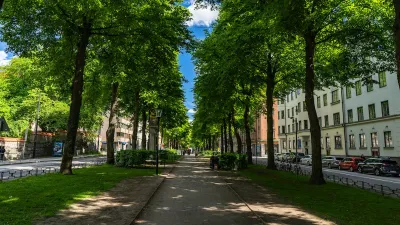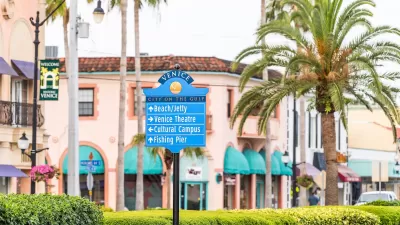Stockholm is seeking bids for a redesign of its city center, and the five plans in contention all seek to fix the damage wrought by modernist planning.
"Built in the mid-1930s, Slussen is a prime candidate for a re-examination of large-scale Modernist planning. Designed to link two sides of the historic city, its concrete entry ramps curl around a cylindrical office building before stretching over an underground bus terminal and the massive locks that regulate boat traffic between Lake Malaren and the Baltic Sea.
In some ways the weaving of a mind-numbing range of transportation systems into a single integrated network made the project a tour de force. But the structure began to deteriorate decades ago, partly because of the poor quality of its concrete construction. Most planners regard it as a lesson in everything that was wrong with orthodox Modernism: endless swaths of barren concrete plazas and dank underpasses that seemed to invite midday muggings.
The competition encourages us to ponder those values with a fresh, unbiased eye. The most intriguing of the five designs can be separated more or less into two categories: those that try to bring clarity and order to the jumbled traffic systems, and those that seek to draw the bustling energy of the old city across the site."
FULL STORY: Bold Plans Prove That a City’s Future Needn’t Be Set in Concrete

Planetizen Federal Action Tracker
A weekly monitor of how Trump’s orders and actions are impacting planners and planning in America.

San Francisco's School District Spent $105M To Build Affordable Housing for Teachers — And That's Just the Beginning
SFUSD joins a growing list of school districts using their land holdings to address housing affordability challenges faced by their own employees.

The Tiny, Adorable $7,000 Car Turning Japan Onto EVs
The single seat Mibot charges from a regular plug as quickly as an iPad, and is about half the price of an average EV.

Even Edmonton Wants Single Staircase Buildings
Canada's second most affordable major city joins those angling to nix the requirement for two staircases in multi-family buildings.

Duffy Threatens to Cut DOT Funds to “Sanctuary Cities”
“Follow the law or forfeit the funding” says US Secretary of Transportation.

Trump Approves Futuristic Automated Texas-Mexico Cargo Corridor
The project could remove tens of thousands of commercial trucks from roadways.
Urban Design for Planners 1: Software Tools
This six-course series explores essential urban design concepts using open source software and equips planners with the tools they need to participate fully in the urban design process.
Planning for Universal Design
Learn the tools for implementing Universal Design in planning regulations.
Smith Gee Studio
City of Charlotte
City of Camden Redevelopment Agency
City of Astoria
Transportation Research & Education Center (TREC) at Portland State University
City of Camden Redevelopment Agency
Municipality of Princeton (NJ)





























